Entry Database : PDB / ID : 6jzdTitle Crystal structure of peptide-bound VASH2-SVBP complex GLU-GLY-GLU-GLU-TYR Small vasohibin-binding protein Tubulinyl-Tyr carboxypeptidase 2 Keywords / / / Function / homology Function Domain/homology Component
/ / / / / / / / / / / / / / / / / / / / / / / / / / / / / / / / / / / / / / / / / / / / / / / / / / / / / / / / / / / / / / / / / / / / / / / / / / / / / / / / / / / / / / / / / / / / / / / / / / / / / / / / / / / / / / / / / / / / / / / / / / / / / / / / / / / / / / Biological species Mus musculus (house mouse)Homo sapiens (human)Method / / / Resolution : 2.479 Å Authors Chen, Z. / Ling, Y. / Zeyuan, G. / Zhu, L. Journal : Nat Commun / Year : 2019Title : Structural basis of tubulin detyrosination by VASH2/SVBP heterodimer.Authors : Zhou, C. / Yan, L. / Zhang, W.H. / Liu, Z. History Deposition May 1, 2019 Deposition site / Processing site Revision 1.0 Jul 17, 2019 Provider / Type Revision 1.1 Jul 24, 2019 Group / Database references / Category / citation_author / Item / _citation_author.nameRevision 1.2 Aug 7, 2019 Group / Database references / Category / citation_authorItem _citation.journal_volume / _citation.page_first ... _citation.journal_volume / _citation.page_first / _citation.page_last / _citation.pdbx_database_id_PubMed / _citation_author.name Revision 1.3 Mar 27, 2024 Group / Database references / Category / chem_comp_bond / database_2Item / _database_2.pdbx_database_accession
Show all Show less
 Open data
Open data Basic information
Basic information Components
Components Keywords
Keywords Function and homology information
Function and homology information
 Homo sapiens (human)
Homo sapiens (human) X-RAY DIFFRACTION /
X-RAY DIFFRACTION /  SYNCHROTRON /
SYNCHROTRON /  MOLECULAR REPLACEMENT / Resolution: 2.479 Å
MOLECULAR REPLACEMENT / Resolution: 2.479 Å  Authors
Authors Citation
Citation Journal: Nat Commun / Year: 2019
Journal: Nat Commun / Year: 2019 Structure visualization
Structure visualization Molmil
Molmil Jmol/JSmol
Jmol/JSmol Downloads & links
Downloads & links Download
Download 6jzd.cif.gz
6jzd.cif.gz PDBx/mmCIF format
PDBx/mmCIF format pdb6jzd.ent.gz
pdb6jzd.ent.gz PDB format
PDB format 6jzd.json.gz
6jzd.json.gz PDBx/mmJSON format
PDBx/mmJSON format Other downloads
Other downloads 6jzd_validation.pdf.gz
6jzd_validation.pdf.gz wwPDB validaton report
wwPDB validaton report 6jzd_full_validation.pdf.gz
6jzd_full_validation.pdf.gz 6jzd_validation.xml.gz
6jzd_validation.xml.gz 6jzd_validation.cif.gz
6jzd_validation.cif.gz https://data.pdbj.org/pub/pdb/validation_reports/jz/6jzd
https://data.pdbj.org/pub/pdb/validation_reports/jz/6jzd ftp://data.pdbj.org/pub/pdb/validation_reports/jz/6jzd
ftp://data.pdbj.org/pub/pdb/validation_reports/jz/6jzd Links
Links Assembly
Assembly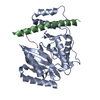
 Components
Components

 Homo sapiens (human) / Gene: SVBP, CCDC23 / Production host:
Homo sapiens (human) / Gene: SVBP, CCDC23 / Production host: 

 X-RAY DIFFRACTION / Number of used crystals: 1
X-RAY DIFFRACTION / Number of used crystals: 1  Sample preparation
Sample preparation SYNCHROTRON / Site:
SYNCHROTRON / Site:  SSRF
SSRF  / Beamline: BL17U1 / Wavelength: 0.9791 Å
/ Beamline: BL17U1 / Wavelength: 0.9791 Å Processing
Processing MOLECULAR REPLACEMENT / Resolution: 2.479→44.11 Å / SU ML: 0.32 / Cross valid method: FREE R-VALUE / σ(F): 1.33 / Phase error: 23.19 / Stereochemistry target values: ML
MOLECULAR REPLACEMENT / Resolution: 2.479→44.11 Å / SU ML: 0.32 / Cross valid method: FREE R-VALUE / σ(F): 1.33 / Phase error: 23.19 / Stereochemistry target values: ML Movie
Movie Controller
Controller





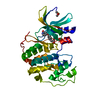
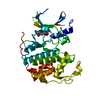
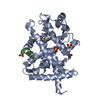
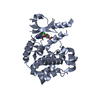
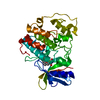
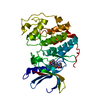
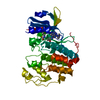
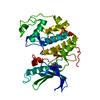
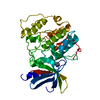
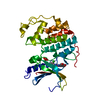
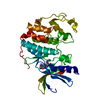
 PDBj
PDBj









